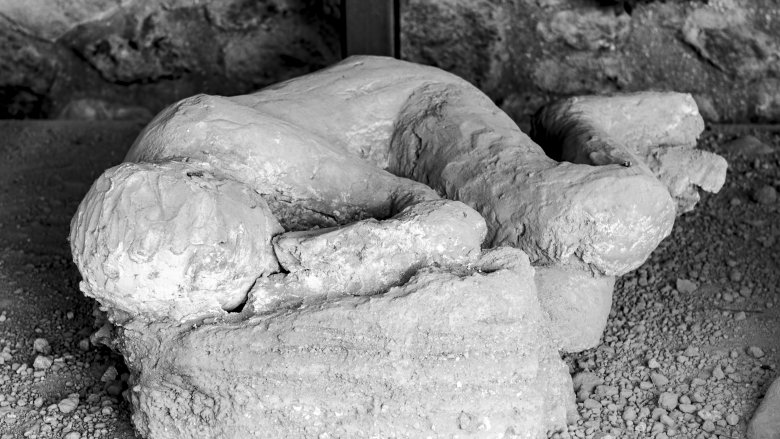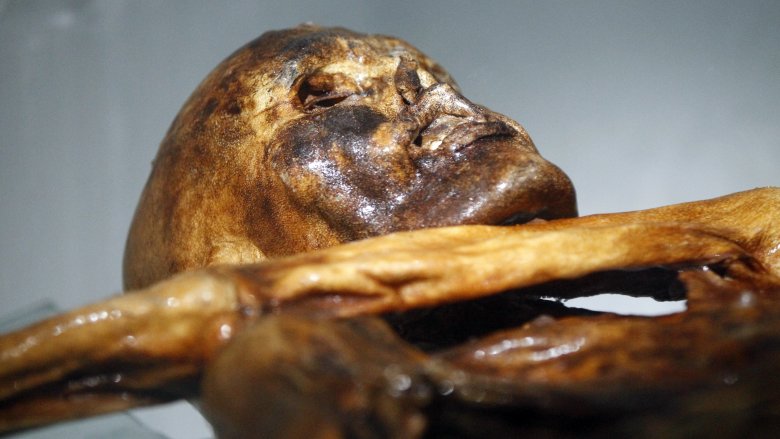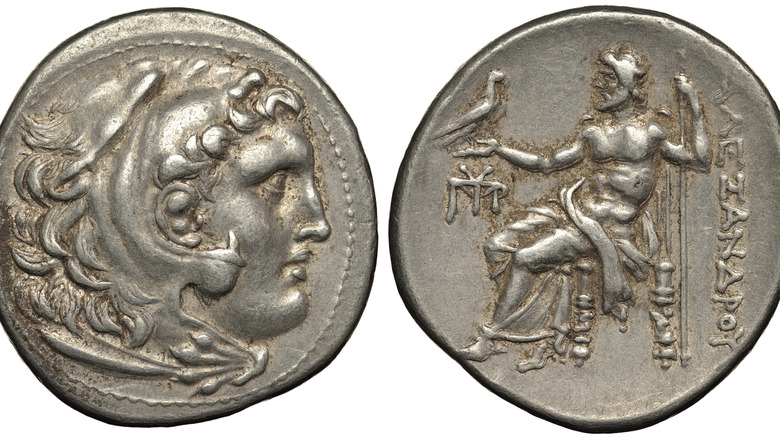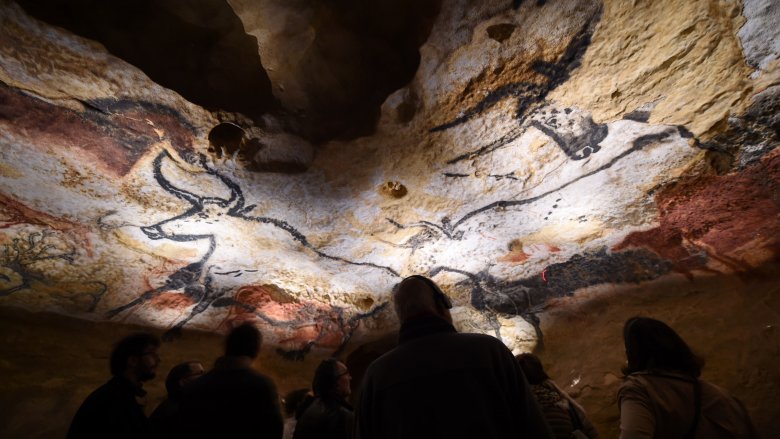Mind-Blowing Archaeological Discoveries Found By Mistake
Archaeologists can spend months sifting through ridiculously small patches of dirt, meticulously recording everything they find from size, shape, and color to precise position in the ground. Months of back-breaking work might turn up some rare finds, or it might turn up absolutely nothing — so just imagine how annoyed archaeologists probably get when they find a fat lot of nothing and some kid in France falls into a hole and discovers the Lascaux cave paintings. A hard fact of the archaeologist life is that great finds do sometimes happen by accident, and are sometimes stumbled upon by non-archaeologists.
Terracotta warriors
In 1974 a group of Chinese farmers single-handedly transformed a land of pomegranate trees and persimmons into a tourist trap. More or less. According to Smithsonian, while digging a well, they discovered the first three of more than 7,000 life-sized terracotta warriors guarding the tomb of China's first emperor Qin Shi Huangdi. And lo, there were hotels and roadside souvenir stands.
The terracotta army buried with the emperor is thought to be one of the greatest archaeological finds of all time. It's not only massive, it's full of individuals — each of the 7,000 warriors has a unique face, beard, tunic, and armor, a curious fact that has led some people to speculate that craftsmen based each warrior on a living person, possibly a soldier in Qin Shi Huangdi's non-terracotta army.
The soldiers were likely meant to protect the emperor in the afterlife, and non-military personnel like servants, scribes, and acrobats were represented as well, which suggests that the emperor hoped the afterlife would be more or less the same as the now-life. Sadly, the terracotta army probably wasn't equipped to help the emperor navigate the crowds of tourists and roadside souvenir stands, so there's that. But happy afterlife anyway.
The Rosetta Stone
Egyptian hieroglyphics were the royal form of written communication, worthy of the tombs of kings and the walls of temples. Then Christianity got popular and everyone freaked out about paganism, so hieroglyphics were eventually banned and replaced with the much-less cool "Coptic" alphabet, which was basically Greek with a few extra characters thrown in to keep things interesting.
Like most of the traditions and languages that were "too pagan" to be allowed to exist, hieroglyphics died right along with the last handful of people who could read and write them, around 1,500 years ago. That left future archaeologists permanently scratching their heads — Egypt had a rich, written history but no one could figure out how to read it.
Then, according to History.com, in 1799 some engineers in Napoleon's army discovered an unusual piece of stone embedded in the wall of Fort Julien in the Egyptian city of Rosetta. Evidently someone needed an extra rock when they were building the wall, and figured that one with the weird writing all over it would do just fine.
On its face, the Rosetta Stone tells about an Egyptian ruler going on about how awesome he was. What's important is the fact that the decree of awesomeness was written in three different languages: Egyptian hieroglyphics, Egyptian demotic, and Greek. And since people still understood how to read Greek, that meant they could figure out the hieroglyphics, too, thus cracking a code that had eluded archaeologists for centuries.
Cool stuff in bogs
Peat bogs are kind of like a cross between Dagobah and a 2,000-year-old, 160-layer cake. Peat moss gets wet, then buried beneath ever-increasing piles of more peat moss, until it forms a 10-foot thick mass of organic matter that cannot be penetrated by light, oxygen, or Luke Skywalker in his pre-Jedi state. Peat bogs also seem to have been appealing places for ancient people to put things, including swords, butter, and murdered people.
Peat cutters find many of the bog bodies, like the Grauballe man, who was initially mistaken for another peat cutter who had gone missing 65 years earlier. Radiocarbon dating later proved the Grauballe man wasn't just a guy who got drunk and fell into the bog — he'd been left there more than 2,000 years earlier by whoever murdered or sacrificed him. (We'll probably never know which one it was.)
Other accidental peat bog discoveries include the extremely well-preserved 14th-century longsword pulled out of the bog by a guy operating an excavator (imagine how bummed that medieval knight must have felt as he watched that thing slip beneath the surface) and still-edible butter. Yes, edible butter, which theoretically could be used to make a layer cake, though we really, really hope no one tried.
Body-shaped bubbles at Pompeii
When Mount Vesuvius told the people of Pompeii, "Hey I'm going to explode in a couple of days, best get the hell out of there," most everyone was all, "Hmm, maybe we'd better get the hell out of here." But as with pretty much every scientifically irrefutable warning of imminent doom, there were a few people who decided it probably wasn't really going to be as bad as everyone said it would be and just pretended like everything was cool, even though it was about to be the opposite of cool.
A couple of thousand years later, workers excavating the devastated city noticed that they were finding a lot of skeletons in weird hollows in the ground, and it occurred to someone that the mud and ash from the erupting volcano might have hardened around its victims, possibly retaining the shape of those people during their last moments. The hunch turned out to be correct. When workers poured plaster into the hollows, they recreated the ghostly, three dimensional shapes of the dead, many of them clearly writhing in pain or screaming as the hot mud and ash covered them. It was kind of like the world's first 3-D printer, only considerably more horrific.
40 ancient shipwrecks in the Black Sea
Imagine that you're commissioned to go out on a boat and study water levels. Now, this sounds about as interesting as getting paid to watch a pot of water come to a boil like 40 or 50 times a day, but then you find a shipwreck. Then you find another shipwreck. Suddenly, your job is super cool.
According to Quartz Media, that's what happened when The Black Sea Maritime Archaeology Project tried to find out how quickly water levels rose in the Black Sea 20,000 years ago at the end of the last ice age. While mapping the underwater landscape, researchers happened to stumble upon a whole bunch of shipwrecks — more than 40 of them — some thousands of years old but still surprisingly well-preserved. The team photographed the wrecks and then used the photos to build 3-D models, many of which represent ship designs never before seen.
The principle investigator on the project called the discovery of the wrecks a "complete bonus," which is kind of like saying that winning the lottery is a "complete bonus," but hey, maybe he doesn't want anyone to know how boring his job is and was trying not to sound too enthusiastic. Now back to that boiling water.
A bunch of headless Vikings
The cool thing about working construction in Great Britain is that you never know when you're going to encounter a first-century Roman fresco, the lost chapel of a villainous English king, or the remains of one of the oldest homes in Britain. In June 2009, workers were doing the preliminary excavation for a roadworks project when they discovered the skeletons of 51 men, according to National Geographic. Carbon dating identified the men as Vikings who were most likely executed for the crime of being Vikings, which is expected, since being a brutal, remorseless killer was basically a prerequisite for getting into Viking University. Based on the state and positions of the bodies, archaeologists deduced that the men had been lined up, decapitated, and then thrown into a mass grave, which would have been unpleasant enough by itself. On top of that, however, they were naked, so if someone was passing out lifetime achievement prizes for suckiest death ever, those poor dudes would definitely be in the running.
18th-century Mayan mural in some guy's kitchen
One of the cool things about living in an old house is that you never really know what kind of history you might find there. People have discovered relics in attics, in basements, in secret rooms, and buried in the backyard. For Lucas Asicona Ramirez, the treasure was under the wall of his kitchen — or rather, was the wall of his kitchen.
When Ramirez began scraping away the plaster during a home renovation, he discovered an 18th-century Mayan mural depicting people walking around with what appear to be human hearts in their hands, also known as a typical day at the Mayan office. In October 2012, Reuters reported that the Ramirez home is one of four in Ramirez's Guatemalan village where residents have uncovered ancient Mayan murals beneath the plaster, and experts think there could be murals in other homes, too.
Sadly, now that the murals have been exposed to light and humidity, the colors are starting to fade — that's one of the hazards of non-archaeologist archaeological discoveries. Unless someone with an interest in Mayan art shows up with a bag of mural-preserving supplies, the ancient murals will probably succumb to the elements in a relatively short period of time.
Otzi
In 1991, German hikers exploring a glacier on the Austrian-Italian border discovered the mummified corpse of a man who lived around 3,300 B.C. He was so well-preserved that at first everyone thought he was a modern-day missing person. That initial theory was supported by current events — the glacier was melting and there had already been a rash of body discoveries in Austria that season, most of which were people who disappeared while hiking.
So that was a problem because officials weren't too careful when they removed the corpse from the ice. They used a jackhammer and an ice pick and tried to pry him out with the remains of his (Copper Age) bow. They also rather spectacularly failed to comprehend the fact that he was dressed in fur and carrying an ax made of copper, which is not something you've been able to pick up at Home Depot for at least the last several thousand years. By the time they got him out, they'd gouged a hole in his hip, broken his arm, and shredded his clothing. But all's fair in love and ancient corpse recovery.
At some point it did eventually occur to someone that the iceman was not an unfortunate hiker but rather an unfortunate murder victim. The 5,000-year-old corpse, nicknamed Otzi, died when an arrow severed his artery, and he stayed pretty much exactly where he had fallen until a bunch of clueless guys with a jackhammer came along five millennia later.
Dead Sea Scrolls
Throwing a rock is almost never a productive activity — most people who throw rocks are bored kids who end up breaking either someone's window or someone's head. But in 1947 the world's most fruitful stone toss ended up breaking a piece of ancient pottery hidden in a Bedouin cave and bringing the Dead Sea Scrolls to the world.
The shepherd who threw the rock was chasing a stray sheep when he found the mouth of a cave in a rocky hillside. And what do you do when you find a cave? You throw a rock in it. The shepherd heard the sound of breaking pottery and decided to venture inside, where he discovered the clay jars that held the Dead Sea Scrolls.
The shepherd and his friends recovered the scrolls and took them to an antiques dealer in Bethlehem, who, in keeping with the sacred tradition of antiques dealers throughout the ages, gave them the equivalent of about $29. Fifty-six years later, they were sold for $250,000, and those shepherds are probably still out there, throwing rocks in caves in the hope that they'll maybe find something just as good and not make the same mistake again.
An 18th-century ship under the World Trade Center
Nobody expected to find anything good near the ruins of the World Trade Center, but they did. According to National Geographic, In 2010, workers who were excavating the future site of an underground vehicle security center discovered the bones of an 18th-century ship. Using the old science of tree-ring dating, researchers learned that the ship had been built from timbers harvested in Pennsylvania around 1773.
How did the ship end up underground near the World Trade Center? In the 1790s, the city of New York wanted to extend the banks of the Hudson river, so they dumped a bunch of crap there — including the 20-year-old sloop, which was suffering from a nasty case of shipworm and may have been deemed most useful as landfill. With the ship, workers also found ceramic tableware, bottles, and shoes, which seems to confirm the theory that the old ship was just the 18th-century version of a week's worth of Starbucks cups.
After it was removed from the ground, the ship was transported to the Maryland Archaeological Conservation Laboratory, where it has a new destiny as a museum piece, thereby confirming the old idiom, "one era's trash is another era's archaeological bonanza."
Cache of ancient coins and jewelry from the time of Alexander the Great
Spelunking is more than just a hobby with the coolest name ever. It's also an opportunity to find awesome stuff — though to be fair, most spelunkers just find rocks, occasional bones, and rabies. But in 2015, Business Insider reported spelunkers exploring a cave in northern Israel got lucky when they stumbled upon a cache of coins and jewelry dating back 2,300 years to the time of Alexander the Great. Archaeologists think the cache might have been hidden there during the Wars of the Diadochi. During times of political unrest, people sometimes sought to protect their wealth by hiding it.
Further investigation into the cave turned up additional objects, some as old as 6,000 years, which suggests that the cave was "hiding stuff during political unrest" central, although one wonders why no one ever came back to retrieve their goods after the politics got a little more restful.
In Israel, no one gets to keep the stuff they find if it's considered an antiquity, which means that everything cool and interesting you find in a cave actually belongs to the state, except maybe for rocks and rabies. So even though spelunking is still the coolest name for a hobby there is, it's probably more profitable to spelunk somewhere other than the Holy Land.
Bones of earliest known Native American ancestor
In yet another example of cool things found in caves, divers exploring an underwater cave in 2007 in Mexico's Eastern Yucatan Peninsula found a human skeleton, according to Seeker. Now, finding skeletons underwater isn't the most unusual thing ever because people who drown are more likely to disappear forever than people who, say, have heart attacks at Denny's. But this find was unusual because it came at the bottom of a cave that was literally called The Black Hole, about 170 feet underwater.
At first, researchers more or less left the skeleton alone. It was photographed, videotaped, 3-D-modeled and "minimally sampled," but because of its potential to stir up controversy it was left in place. Until recently, when a bunch of people went diving in the cave without permission, and officials started to worry that the remains would be disturbed or damaged.
Once the skeleton was in the hands of researchers, they could date it, and they discovered that it was the oldest known Native American ancestor, dated between 12,000 and 13,000 years ago. The girl, who was 15 or 16 years old, probably walked into the cave and then fell into the deeper pit, which would have contained only a shallow pool of water. A few thousand years later, glacial melt filled the pit, submerging her bones and keeping them remarkably well-preserved until someone was finally able to solve the mystery of her death, thousands of years after everyone who mourned her was gone.
Lascaux cave paintings
In what is one of the most famous accidental discoveries of all time, four boys and a dog named Robot were out for a walk one day when they happened upon a fallen tree, which had punched a partial hole in the ground. Robot, being a dog, was all "Hot damn, a hole," and started digging. The four boys joined him, imagining they might have found the entrance to a tunnel that would take them to a lost treasure.
What they found was indeed a lost treasure, just not the kind you can stuff in your pockets and sell to an antiques dealer for $29. Instead, they discovered a cave full of 20,000-year-old paintings made by Cro-Magnon, an early modern human. The paintings are exquisitely detailed and some of them are huge — more than 10 or 15 feet in length.
In 1948, a year after their discovery, Lascaux was opened to the public, but 15 years later someone finally realized that tourism was bad for the paintings. All the carbon dioxide exhaled by thousands of eager visitors along with contaminants they brought in on their shoes was actually damaging the paintings, so the tours had to end. Today only a few people a year are allowed inside the caves, and their actions are limited mainly to trying to prevent additional damage to those amazing but fragile works of art.







